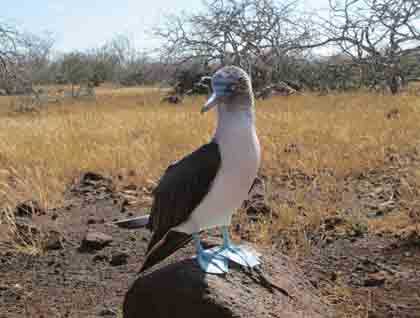After spending our first night in the Galapagos, we started our expedition visiting two of the most beautiful islands in the central realm of the archipelago—North Seymour and Rábida Islands.
Early in the morning, we disembarked to explore North Seymour. At the distance, the island looks barren, but everything changed dramatically when we discovered exuberant fauna along the dry vegetation and flat terrain. Yellow land iguanas and colorful frigate birds with their bright red pouches inflated colored the landscape, giving renewed life to this place which has not received rainfall for many months. Of course, sea birds don’t need fresh water, but the land animals struggle to survive on this inhospitable terrain at this time of year. We saw thirsty land iguanas devouring succulent plants such as salt bush and cactus to quench their thirst. Along the path, we also observed blue-footed boobies and their young chicks with their white coat of downy feathers. These birds seem to be doing very well on this island several were observed feeding along the coast as well.
As soon as we left North Seymour, we navigated northwest towards Rábida Island. Its unique red sandy beach and hills covered with green vegetation, contrasted with what we had observed at North Seymour, but great surprises were awaiting for us here as well. With radiant sun and perfect weather conditions, we started our activities snorkeling along the crystalline waters, observing green sea turtles, white-tipped reef sharks, playful sea lions and incredible garden eels, which embellished the sandy bottom with their long bodies, disappearing under the sandy sea floor at our first attempt to approach to them.
After a fun snorkeling outing, we returned to the National Geographic Endeavour and prepared for a walk along the coast of Rábida, where Galapagos sea lions live in a colony. Many adult females and some youngsters were observed relaxing and enjoying the last warm rays of light. We hiked to a small lagoon behind the beach, where two flamingos fed on crustaceans along the muddy bottom, while in the air, a Galapagos hawk flew freely, looking for some food. With the last beams of sun, we started our walk back to the beach, when we observed five more flamingos flying around the lagoon, deciding whether or not to land. After a few minutes of flying overhead, they finally landed and like the others, proceeded to feed along the shallow area, moving their bills quickly through the water. It was exciting to experience the tameness of these animals, and we were able to stand only a few meters from them, making it possible to observe their magnificent plumage and hear the noise produced by their bills. It was late and dark when we returned to the National Geographic Endeavour, leaving incredible creatures behind but taking fantastic memories of this unique place.







